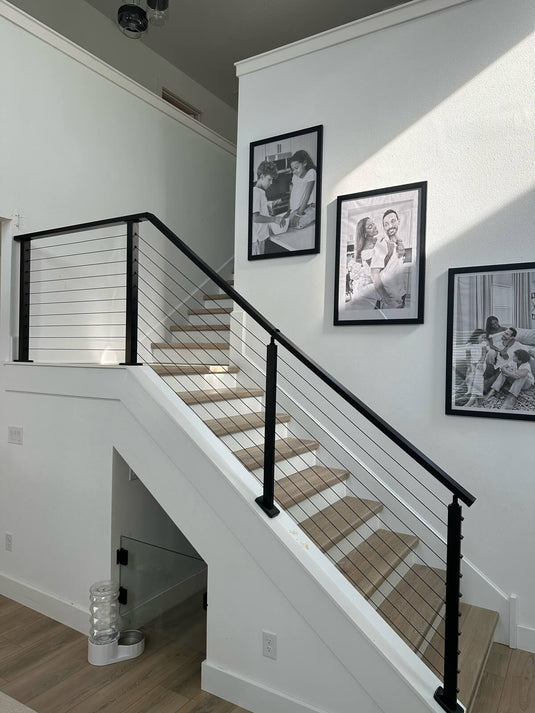TABLE OF CONTENTS
How to Build Floating Stairs: A Step-by-Step Guide
Floating stairs are a striking, modern feature that can dramatically enhance any space. Their minimalist design, with steps that appear to float, creates an open, airy atmosphere while adding a sophisticated touch to your home. The installation process, however, may seem daunting due to the complexity of the design. Incorrect installation may also lead to serious safety risks, such as instability or even failure of the stairs, potentially resulting in accidents or costly repairs.
With proper planning and expert guidance, even beginners with basic construction skills can achieve a professional finish. Seeking professional advice can help tackle common challenges, including selecting the right materials, ensuring structural integrity, and complying with building codes.
In this guide, we’ll walk you through the essential steps of building floating stairs, ensuring that you have everything you need to create a stunning and safe addition to your home. Let’s get started!
Understanding Floating Stairs
What are Floating Stairs?
Floating stairs are a modern and visually striking type of staircase designed to appear as though they are "floating" without any visible support. These stairs typically feature open risers and minimal structural elements, allowing light to pass through. The treads are mounted to the wall or supported by a hidden stringer or bracket, giving the illusion that they are suspended in mid-air.
Why Choose Floating Stairs?
Floating stairs provide several benefits. Firstly, their open design allows light to flow freely through the space, creating a sense of openness and depth. They are also space-efficient, making them ideal for smaller or open-plan areas. Lastly, their modern design adds a touch of sophistication, making them a focal point in contemporary homes or commercial spaces.

Tools You’ll Need
Understanding the tools is crucial when learning how to build stairs, as it ensures you can work efficiently and safely throughout the construction process.
● Measuring Tape: A high-quality measuring tape will allow you to measure tread depth, rise, and stringer placement with precision. Always double-check your measurements to avoid mistakes.
● Level: A level is indispensable for ensuring that each step is perfectly horizontal and properly aligned. It helps prevent any unevenness in the structure, ensuring the stairs are both functional and visually appealing.
● Drill with Various Bits: A drill is essential for creating holes in the supports and treads. Make sure to have a selection of drill bits on hand for different materials, such as wood, metal, or concrete. Use the right bit for the material you're working with to ensure a secure fit for screws and bolts.
● Saw: Depending on the materials you choose for your floating stairs, you'll need a saw to cut the treads, stringers, or supports. A wood saw is ideal for cutting wooden elements, while a metal cutter or jigsaw will be required for cutting metal parts.
● Screwdrivers: You’ll need both flathead and Phillips head screwdrivers to install screws and bolts. These will be useful when attaching the treads to the stringers and securing other structural components.
● Wrench Set: A wrench set is necessary for tightening bolts and securing structural elements like the stringers and supports. A socket wrench with different-sized sockets will help ensure you can fasten bolts firmly without over-tightening.
● Stud Finder: If your floating stairs will be mounted to a wall, a stud finder will be critical. It helps locate the secure anchor points in the wall, ensuring that the stringers are safely attached to the studs, providing strength and stability for the entire structure.
Step-by-Step Guide on How to Build Floating Stairs
In the following sections, we will show you how to build a floating staircase, from measuring to installing structural support and securing the treads. By taking it one step at a time and staying organized, you can successfully create a floating staircase that transforms your space. Let’s start with the planning and design phase.
Step 1: Plan Your Design
Before diving into the construction of your floating stairs, careful planning is key to achieving a functional and visually appealing result.
● Measure the Height Between Floors
Before starting, measure the height between the floors where the floating staircase will be installed. This measurement will determine the rise of each step and ensure that the stairs are comfortable to climb.
● Choose Your Materials
Floating staircases often incorporate a mix of materials such as wood, metal, and glass. For example, wooden treads with metal stringers or glass railings can create a modern, striking design. Carefully select materials that suit your aesthetic preferences and structural needs.
● Consider Layout and Space
Plan the layout of the stairs to ensure they fit comfortably within the space. Be mindful of surrounding features such as doorways, windows, and furniture. Proper planning will ensure the staircase complements the overall design and flows naturally within the room.
● Check Building Codes
Before proceeding, it’s essential to verify local building codes and regulations. Ensure your staircase design meets safety standards regarding dimensions, load-bearing capacity, and the installation of handrails or guardrails. Following these codes will help guarantee the staircase's safety and compliance.

Step 2: Prepare the Structural Support
The structural support is the backbone of your floating staircase, ensuring both stability and safety. Here's how to prepare it:
● Attaching Stringers or Brackets to the Deck or Wall
The stringers (or supporting beams) are crucial for the strength and stability of floating stairs, while also preserving their characteristic "floating" appearance.
Single Stringer Structure: For single stringer stairs, a single central spine beam (stringer) is typically used. This spine should be securely fixed between the designated positions on both the upper and lower floors where the floating staircase will be installed. The central beam is usually anchored to the wall at the top and connected to a support beam or hidden within the wall for a clean, seamless look.
Double Stringer Structure: For more complex or larger designs, two parallel stringers are often used. These prefabricated stringers should be fixed between the installation positions on the upper and lower floors. Ensuring both stringers are parallel and securely anchored is crucial to provide maximum stability and support for the treads.
For both structures, the stringers should be made of durable materials like stainless steel to provide strength and long-lasting support. Ensure all components are securely anchored to both the wall and the floor to bear the weight of the stairs.

Single Stringer Stairs

Dual Stringer Stairs
● Install Hidden Supports
For a sleek, minimalist design, many modern floating staircases hide their supports within the wall, allowing the treads to appear as though they are floating. This requires creating a recess or niche in the wall for the stringers or brackets to sit in. This type of installation creates a seamless look, offering a floating effect while still providing ample strength and stability. Ensure that the wall is structurally sound enough to accommodate this type of installation, and that the hidden supports are properly fixed to withstand the weight of the stairs.

Step 3: Mount the Treads
After setting up the structural support, the next step is to install the treads. These surfaces, which will bear the weight of foot traffic, must be securely fastened to the stringers or brackets.
● Install Tread Supports
For floating stairs, tread supports are essential for securing the treads and ensuring their stability. These frames should be attached to both the stringers and the treads to create a solid, secure connection. They can be made of metal, wood, or a combination of materials, depending on the design. These supports prevent the treads from shifting or sagging over time, ensuring long-lasting durability.
● Install the Treads
Once the supports are installed, carefully place the treads onto the supports. Secure each tread to the support system using the appropriate fasteners. Depending on the design, these may be screws, bolts, or hidden fasteners that give the appearance of a floating, seamless stair. Ensure that each tread is level and aligned before tightening everything into place.
● Safety Considerations
Safety is a critical factor when installing floating stairs. After mounting each tread, make sure it is securely attached to the support frame and stringers. Double-check the sturdiness by applying pressure to each tread to ensure no wobbling or movement. Floating stairs rely on their structural integrity, and any instability in the treads can compromise the entire staircase. If any tread feels loose or unstable, reinforce the connections immediately. Additionally, ensure all edges of the treads are smooth and free of sharp corners to prevent any safety hazards.
Step 4: Final Touches and Aesthetic Details
Once the structural elements are in place and the stairs are secure, it's time to add the finishing touches. This includes surface treatment and decoration to match the aesthetic of your home or commercial space.
● Lighting
Floating stairs are a perfect opportunity to integrate lighting into your design. LED strips or recessed lighting under the treads can add an elegant touch while improving visibility and safety.
● Handrails and Guardrails
In addition to their safety function, handrails and guardrails can also be a key part of the design. Consider using modern materials like stainless steel or glass for a sleek, sophisticated look.
● Surface Finishes
Depending on the materials you've chosen, you may want to add surface finishes such as varnishing wooden treads or polishing metal components to enhance their appearance.

Conclusion
Building floating stairs can be a challenging yet rewarding project. With careful planning, attention to detail, and a focus on safety, you can create a stunning staircase that enhances the look and functionality of your space. Whether you're constructing the stairs yourself or hiring a professional, following the steps outlined in this guide will help ensure that your floating stairs are safe, secure, and visually appealing.
At Muzata, we specialize in designing and building modern floating stairs that perfectly blend style with function. If you want to save time and effort, fill out our free design form today and start your journey toward the perfect staircase!
FAQs
📌How much does it cost to build floating stairs?
The cost of building floating stairs can vary significantly depending on factors such as the materials used, the complexity of the design, and the installation process. High-end materials like glass, custom wood, or steel can push the price higher. For a more detailed cost breakdown, check out this article on floating stairs cost.
📌How to make floating stairs safe?
To make floating stairs safe, it's essential to ensure they comply with building codes, use strong materials, and are installed correctly. The stringers must be securely anchored to both the floor and the landing, and the treads must be properly fastened. Additionally, handrails should be installed at the appropriate height and tested for stability. It's also important to regularly inspect the stairs to ensure there's no deflection or wobbling. If you're unsure about the installation, consulting a professional can help guarantee safety.
📌How do you calculate stairs steps?
To calculate stair steps, you need to know the total rise (the vertical distance between floors) and the desired riser height (the height of each step). Divide the total rise by the riser height to determine the number of steps. For example, if the total rise is 100 inches and you select a 7.5-inch riser height, divide 100 by 7.5 to get approximately 13 steps. Additionally, ensure the tread depth (horizontal part of the step) is comfortable, usually between 10 and 11 inches.




